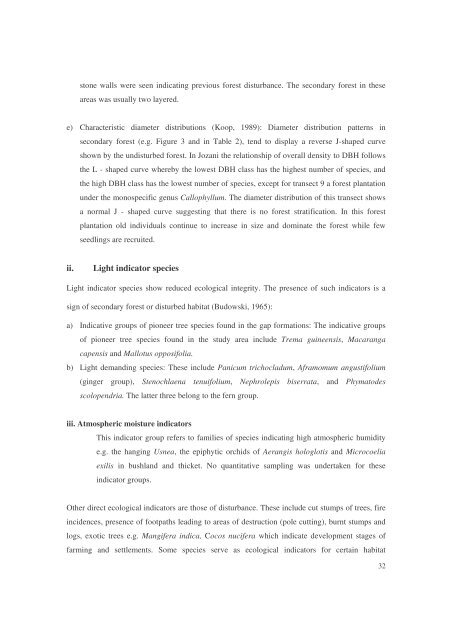Jozani biodiversity inventory report 2002 - Coastal Forests of Kenya ...
Jozani biodiversity inventory report 2002 - Coastal Forests of Kenya ...
Jozani biodiversity inventory report 2002 - Coastal Forests of Kenya ...
Create successful ePaper yourself
Turn your PDF publications into a flip-book with our unique Google optimized e-Paper software.
stone walls were seen indicating previous forest disturbance. The secondary forest in these<br />
areas was usually two layered.<br />
e) Characteristic diameter distributions (Koop, 1989): Diameter distribution patterns in<br />
secondary forest (e.g. Figure 3 and in Table 2), tend to display a reverse J-shaped curve<br />
shown by the undisturbed forest. In <strong>Jozani</strong> the relationship <strong>of</strong> overall density to DBH follows<br />
the L - shaped curve whereby the lowest DBH class has the highest number <strong>of</strong> species, and<br />
the high DBH class has the lowest number <strong>of</strong> species, except for transect 9 a forest plantation<br />
under the monospecific genus Callophyllum. The diameter distribution <strong>of</strong> this transect shows<br />
a normal J - shaped curve suggesting that there is no forest stratification. In this forest<br />
plantation old individuals continue to increase in size and dominate the forest while few<br />
seedlings are recruited.<br />
ii.<br />
Light indicator species<br />
Light indicator species show reduced ecological integrity. The presence <strong>of</strong> such indicators is a<br />
sign <strong>of</strong> secondary forest or disturbed habitat (Budowski, 1965):<br />
a) Indicative groups <strong>of</strong> pioneer tree species found in the gap formations: The indicative groups<br />
<strong>of</strong> pioneer tree species found in the study area include Trema guineensis, Macaranga<br />
capensis and Mallotus opposifolia.<br />
b) Light demanding species: These include Panicum trichocladum, Aframomum angustifolium<br />
(ginger group), Stenochlaena tenuifolium, Nephrolepis biserrata, and Phymatodes<br />
scolopendria. The latter three belong to the fern group.<br />
iii. Atmospheric moisture indicators<br />
This indicator group refers to families <strong>of</strong> species indicating high atmospheric humidity<br />
e.g. the hanging Usnea, the epiphytic orchids <strong>of</strong> Aerangis hologlotis and Microcoelia<br />
exilis in bushland and thicket. No quantitative sampling was undertaken for these<br />
indicator groups.<br />
Other direct ecological indicators are those <strong>of</strong> disturbance. These include cut stumps <strong>of</strong> trees, fire<br />
incidences, presence <strong>of</strong> footpaths leading to areas <strong>of</strong> destruction (pole cutting), burnt stumps and<br />
logs, exotic trees e.g. Mangifera indica, Cocos nucifera which indicate development stages <strong>of</strong><br />
farming and settlements. Some species serve as ecological indicators for certain habitat<br />
32
















